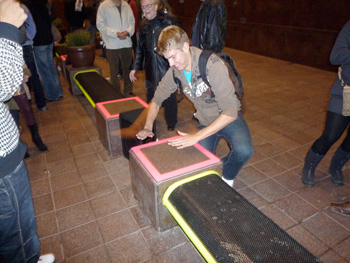
Joanna Chin
Join Our First Animating Democracy Blog Salon
Posted by Nov 07, 2011

Joanna Chin
Community connections are being eroded on multiple sides. There are growing divisions amongst Americans on how to deal with our social, economic, and political problems. Technology is making it possible to never physically interact with another human being and warping the way we relate to one another. Small towns and cities alike are losing their sense of identity and facing crises involving lack of affordable housing and declining social services.
Perhaps in reaction to this erosion of community ties, there’s been an increased interest in cultivating civic engagement, placemaking, and change at a local level.
There is a growing body of evidence and examples of how communities have utilized local assets in order to begin to address this problem. We assert that the arts and culture have always had a place in this work of creating a sense of place, strengthening civic participation, and bolstering positive social change.
For this Blog Salon, we’ve dared our bloggers to answer big questions, like:
- Where do you see breakthrough work at the intersection of art and community, civic, or social change? What makes it effective?
- Looking to the future, what will it take to move and sustain arts and culture into its most potent role in community development, civic engagement, and social change?
- What are the principles we have to hold onto and what are the shifts that need to occur?
Read More

















 According to the Forum of Regional Associations of Grantmakers, giving circles are a growing trend in philanthropy that is rooted in tradition and here to stay. Also called donor circles, they are a relatively simple way for everyday people to pool their money and decide together where to give it away. They have emerged over the last decade as a significant philanthropic trend among donors of all wealth levels and backgrounds. The Forum has identified more than 400 circles across the country engaging more than 12,000 donors, and giving close to $100 million over the course of their existence.
According to the Forum of Regional Associations of Grantmakers, giving circles are a growing trend in philanthropy that is rooted in tradition and here to stay. Also called donor circles, they are a relatively simple way for everyday people to pool their money and decide together where to give it away. They have emerged over the last decade as a significant philanthropic trend among donors of all wealth levels and backgrounds. The Forum has identified more than 400 circles across the country engaging more than 12,000 donors, and giving close to $100 million over the course of their existence.






 The Wing Luke Asian Museum is recognized within the field as a model of community arts programming and engagement for their long-term commitment to exploring issues related to the culture, art, and history of Asian-Pacific Americans. In this conversation with Cassie Chinn, Deputy Executive Director at The Wing Luke Asian Museum, get a taste of the story that staff from the museum, community members, and artists will share at the session in June. Cassie offers listeners perspective on the museum’s programming in June (definitely stop by and check out their new space if you’re able!), and gives listeners a good idea of the museum’s innovative model for partnership and programming through work with communities. Further, she offers listeners interested in replicating this work on the local level a few pointers on how to begin to think through philosophy and mind-set.
The Wing Luke Asian Museum is recognized within the field as a model of community arts programming and engagement for their long-term commitment to exploring issues related to the culture, art, and history of Asian-Pacific Americans. In this conversation with Cassie Chinn, Deputy Executive Director at The Wing Luke Asian Museum, get a taste of the story that staff from the museum, community members, and artists will share at the session in June. Cassie offers listeners perspective on the museum’s programming in June (definitely stop by and check out their new space if you’re able!), and gives listeners a good idea of the museum’s innovative model for partnership and programming through work with communities. Further, she offers listeners interested in replicating this work on the local level a few pointers on how to begin to think through philosophy and mind-set.



